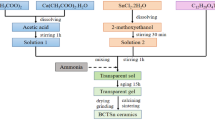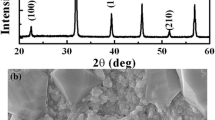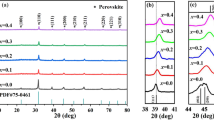Abstract
Lead-free Ba0.85Ca0.15Zr0.1Ti0.9O3 (BCZT) ceramic powders were synthesized using the sol–gel method. The ceramics thickness was reduced to achieve high-energy storage and large electrocaloric effect in bulk ceramics. Dielectric, ferroelectric, energy storage, and electrocaloric properties were investigated for BCZT ceramic with 400 µm. Here, pure crystalline structure and homogenous microstructure were identified by XRD analysis and SEM measurements, respectively. The dielectric measurements revealed a maximum dielectric constant associated with ferroelectric–paraelectric phase transition. The maximum of \(\varepsilon^{\prime}_{{\text{r}}}\) was 17841, around 352 K. Furthermore, the BCZT ceramic exhibited improved energy storage and electrocaloric properties. A high recoverable energy density Wrec of 0.24 J/cm3 and a total energy density Wtotal of 0.27 J/cm3 with an efficiency coefficient of ~ 88% at 423 K under an electric field of 55 kV/cm were obtained. Besides, The maximum value of ΔT = 2.32 K, the electrocaloric responsivity ζ = 0.42 K mm/kV, the refrigeration capacity RC = 4.59 J/kg and the coefficient of performance COP = 12.38 were achieved around 384 K under 55 kV/cm. The total energy density Wtotal and the temperature change ΔT were also calculated by exploiting the Landau–Ginzburg–Devonshire (LGD) theory. The theoretical results matched the experimental findings. These results suggest that the synthesized BCZT ceramic with reduced thickness could be a promising candidate for energy storage and electrocaloric applications.











Similar content being viewed by others
Data availability
Not applicable.
Code availability
Not applicable.
References
Y. Xu, Ferroelectric materials and their applications (Elsevier, New York, 2013)
R.E. Cohen, Origin of ferroelectricity in perovskite oxides. Nature 358(6382), 136–138 (1992). https://doi.org/10.1038/358136a0
S. Zhang, F. Li, High performance ferroelectric relaxor-PbTiO3 single crystals: Status and perspective. J. Appl. Phys. 111(3), 031301 (2012). https://doi.org/10.1063/1.3679521
L. Wu, C.-C. Wei, T.-S. Wu, C.-C. Teng, Dielectric properties of modified PZT ceramics. J. Phys. C: Solid State Phys. 16(14), 2803–2812 (1983). https://doi.org/10.1088/0022-3719/16/14/020
H.-B. Park, C.Y. Park, Y.-S. Hong, K. Kim, S.-J. Kim, Structural and dielectric properties of PLZT ceramics modified with lanthanide ions. J. Am. Ceram. Soc. 82(1), 94–102 (1999). https://doi.org/10.1111/j.1151-2916.1999.tb01728.x
P.K. Panda, B. Sahoo, PZT to lead free piezo ceramics: a review. Ferroelectrics 474(1), 128–143 (2015). https://doi.org/10.1080/00150193.2015.997146
Y. Huan, X. Wang, J. Fang, L. Li, Grain size effect on piezoelectric and ferroelectric properties of BaTiO3 ceramics. J. Eur. Ceram. Soc. 34(5), 1445–1448 (2014). https://doi.org/10.1016/j.jeurceramsoc.2013.11.030
K. Sakayori et al., Curie temperature of BaTiO3. Jpn. J. Appl. Phys. 34(9S), 5443 (1995). https://doi.org/10.1143/JJAP.34.5443
X.M. Chen, T. Wang, J. Li, Dielectric characteristics and their field dependence of (Ba, Ca)TiO3 ceramics. Mater. Sci. Eng. B 113(2), 117–120 (2004). https://doi.org/10.1016/j.mseb.2004.04.003
T. Badapanda, S. Chaterjee, A. Mishra, R. Ranjan, S. Anwar, Electric field induced strain, switching and energy storage behaviour of lead free Barium Zirconium Titanate ceramic. Physica B 521, 264–269 (2017)
D. Xue, Y. Zhou, H. Bao, J. Gao, C. Zhou, X. Ren, Large piezoelectric effect in Pb-free Ba(Ti, Sn)O3–x(Ba, Ca)TiO3 ceramics. Appl. Phys. Lett. 99(12), 122901 (2011). https://doi.org/10.1063/1.3640214
P. Julphunthong, S. Chootin, T. Bongkarn, Phase formation and electrical properties of Ba(ZrxTi1−x)O3 ceramics synthesized through a novel combustion technique. Ceram. Int. 39, S415–S419 (2013). https://doi.org/10.1016/j.ceramint.2012.10.105
X.W. Wang et al., Effects of calcining temperature on structure and dielectric and ferroelectric properties of sol–gel synthesized Ba0.85Ca0.15Zr0.1Ti0.9O3 ceramics. J. Electron. Mater. 49(1), 880–887 (2020). https://doi.org/10.1007/s11664-019-07769-4
M.B. Abdessalem, S. Aydi, A. Aydi, N. Abdelmoula, Z. Sassi, H. Khemakhem, Polymorphic phase transition and morphotropic phase boundary in Ba1−xCaxTi1−yZryO3 ceramics. Appl. Phys. A 123(9), 583 (2017). https://doi.org/10.1007/s00339-017-1196-7
W. Liu, X. Ren, Large piezoelectric effect in Pb-free ceramics. Phys. Rev. Lett. 103(25), 257602 (2009). https://doi.org/10.1103/PhysRevLett.103.257602
H. Mezzourh et al., Enhancing the dielectric, electrocaloric and energy storage properties of lead-free Ba0.85Ca0.15Zr0.1Ti0.9O3 ceramics prepared via sol–gel process. Phys. B: Condens. Matter 603, 412760 (2021)
Z. Wang et al., Synthesis, structure, dielectric, piezoelectric, and energy storage performance of (Ba0.85Ca0.15)(Ti0.9 Zr0.1)O3 ceramics prepared by different methods. J. Mater. Sci.: Mater. Electron. 27(5), 5047–5058 (2016). https://doi.org/10.1007/s10854-016-4392-x
M. Maraj, W. Wei, B. Peng, W. Sun, Dielectric and energy storage properties of Ba(1–x)CaxZryTi(1−y)O3 (BCZT): A Review. Materials 12(21), 3641 (2019). https://doi.org/10.3390/ma12213641
Y. Zhang, H. Sun, W. Chen, A brief review of Ba(Ti0.8Zr0.2)O3–(Ba0.7Ca0.3)TiO3 based lead-free piezoelectric ceramics: past, present and future perspectives. J. Phys. Chem. Solids 114, 207–219 (2018). https://doi.org/10.1016/j.jpcs.2017.10.041
X. Ji et al., Structural and electrical properties of BCZT ceramics synthesized by sol–gel process. J. Mater Sci. (2018). https://doi.org/10.1007/s10854-018-8751-7
Y. Yao et al., Large piezoelectricity and dielectric permittivity in BaTiO3−XBaSnO3 system: the role of phase coexisting. Europhys. Lett. (EPL) (2012). https://doi.org/10.1209/0295-5075/98/27008
H. Kaddoussi et al., Indirect and direct electrocaloric measurements of (Ba1−xCax)(Zr0.1Ti0.9)O3 ceramics (x = 0.05, x = 0.20). J. Alloys Compd. 667, 198–203 (2016). https://doi.org/10.1016/j.jallcom.2016.01.159
J. Li et al., Grain-orientation-engineered multilayer ceramic capacitors for energy storage applications. Nat. Mater. 19(9), 999–1005 (2020). https://doi.org/10.1038/s41563-020-0704-x
C. Neusel, H. Jelitto, D. Schmidt, R. Janssen, F. Felten, G.A. Schneider, Thickness-dependence of the breakdown strength: analysis of the dielectric and mechanical failure. J. Eur. Ceram. Soc. 35(1), 113–123 (2015). https://doi.org/10.1016/j.jeurceramsoc.2014.08.028
I. Coondoo, N. Panwar, H. Amorín, M. Alguero, A.L. Kholkin, Synthesis and characterization of lead-free 0.5Ba(Zr0.2Ti0.8)O3–0.5(Ba0.7Ca0.3)TiO3 ceramic. J. Appl. Phys. 113(21), 214107 (2013)
P. Jaimeewong, M. Promsawat, A. Watcharapasorn, S. Jiansirisomboon, Comparative study of properties of BCZT ceramics prepared from conventional and sol-gel auto combustion powders. Integr. Ferroelectr. 175(1), 25–32 (2016). https://doi.org/10.1080/10584587.2016.1199913
Y. Tian, L. Wei, X. Chao, Z. Liu, Z. Yang, Phase transition behavior and large piezoelectricity near the morphotropic phase boundary of lead-free free (Ba0.85Ca0.15)(Zr0.1Ti0.9)O3 ceramics. J. Am Ceram. Soc. 96(2), 496–502 (2013)
S. Belkhadir et al., Structural, dielectric and electrocaloric properties of (Ba0.85Ca0.15)(Ti0.9Zr0.1−xSnx)O3 ceramics elaborated by sol–gel method. J. Mater. Sci 30(15), 14099–14111 (2019)
Z. Hanani et al., Enhanced dielectric and electrocaloric properties in lead-free rod-like BCZT ceramics. J. Adv. Ceram. 9(2), 210–219 (2020)
E.K. Abdel-Khalek, D.A. Rayan, A.A. Askar, M.I.A.A. Maksoud, H.H. El-Bahnasawy, Synthesis and characterization of SrFeO3−δ nanoparticles as antimicrobial agent. J. Sol-Gel Sci. Technol. 97(1), 27–38 (2021). https://doi.org/10.1007/s10971-020-05431-8
H. Kaddoussi et al., Room temperature electro-caloric effect in lead-free) Ba(Zr0.1Ti0.9)1−SnO3(x = 0, x = 0.075) ceramics. Solid State Commun. 201, 64–67 (2015). https://doi.org/10.1016/j.ssc.2014.10.003
S. Merselmiz et al., Enhanced electrical properties and large electrocaloric effect in lead-free Ba0.8Ca0.2ZrxTi1−xO3 (x= 0 and 0.02) ceramics. J. Mater. Sci 31(19), 17018–17028 (2020)
M. Ben Abdessalem, I. Kriaa, A. Aydi, N. Abdelmoula, Large electrocaloric effect in lead-free Ba1−xCaxTi1−yZryO3 ceramics under strong electric field at room-temperature. Ceram. Int. 44(12), 13595–13601 (2018)
S. Patel Sharma, R. Vaish, Enhanced electrocaloric effect Ba0.85Ca0.15Zr0.1Ti0.9–xSnxO3 in ferroelectric ceramics. Phase Transit. 89(11), 1062–1073 (2016)
S. Patel, M. Kumar, Electrocaloric properties of Sr and Sn doped BCZT lead-free ceramics. Eur. Phys. J. Appl. Phys. 91(2), 20905 (2020). https://doi.org/10.1051/epjap/2020200165
Q. Zhang et al., Enhanced piezoelectric response of (Ba, Ca)(Ti, Zr) O3 ceramics by super large grain size and construction of phase boundary. J. Alloy. Compd. 794, 542–552 (2019)
N. Qu, H. Du, X. Hao, A new strategy to realize high comprehensive energy storage properties in lead-free bulk ceramics. J. Mater. Chem. C 7(26), 7993–8002 (2019). https://doi.org/10.1039/C9TC02088H
P. Redhu, A. Hooda Sharma, S. Dahiya, R. Punia, R.P. Tandon, Study of energy storage and electrocaloric behavior of lead-free Fe-doped BCT ceramics. Ferroelectrics 569(1), 136–147 (2020). https://doi.org/10.1080/00150193.2020.1791661
K.R. Kandula, K. Banerjee, S.S.K. Raavi, S. Asthana, Enhanced electrocaloric effect and energy storage density of Nd-substituted 0.92 NBT-0.08 BT lead free ceramic. Phys. Status Solidi (a) 215(7), 1700915 (2018)
W. Cai et al., Synergistic effect of grain size and phase boundary on energy storage performance and electric properties of BCZT ceramics. J. Mater. Sci.: Mater. Electron. 31(12), 9167–9175 (2020)
Z. Hanani et al., Thermally-stable high energy storage performances and large electrocaloric effect over a broad temperature span in lead-free BCZT ceramic. RSC Adv. 10(51), 30746–30755 (2020)
K. Xu Yang, W. Peng, L. Li, Temperature-stable MgO-doped BCZT lead-free ceramics with ultra-high energy storage efficiency. J. Alloys Compd. 829, 154516 (2020)
Q. Zhang et al., Controllable synthesis of (Ba0.85Ca0.15)(Zr0.1Ti0.9)O3 submicron sphere by hydroxide co-precipitation method. Ceram. Int. 46(18), 28285–28291 (2020). https://doi.org/10.1016/j.ceramint.2020.07.331
S. Merselmiz et al., High energy storage efficiency and large electrocaloric effect in lead-free BaTi0.89Sn0.11O3 ceramic. Ceram. Int. 46(15), 23867–23876 (2020). https://doi.org/10.1016/j.ceramint.2020.06.163
Z. Jiang, S. Prosandeev, L. Bellaiche, Energy storage in lead-free Ba(Zr, Ti)O3 relaxor ferroelectrics: Large densities and efficiencies and their origins. Phys. Rev. B 105(2), 024102 (2022). https://doi.org/10.1103/PhysRevB.105.024102
Y. Hou, J. Li, J. Ding, T. Ye, R. Liang, Giant electrocaloric response in compositional manipulated BaTiO3 relaxor–ferroelectric system. J. Appl. Phys. 127(6), 064103 (2020). https://doi.org/10.1063/1.5142635
A.S. Mischenko, Q. Zhang, J.F. Scott, R.W. Whatmore, N.D. Mathur, Giant electrocaloric effect in thin-film PbZr0.95Ti0.05O3. Science 311(5765), 1270–1271 (2006). https://doi.org/10.1126/science.1123811
Z. Kutnjak, B. Rožič, R. Pirc, Electrocaloric effect: theory, measurements, and applications, in Wiley Encyclopedia of Electrical and Electronics Engineering. ed. by J.G. Webster (Wiley, Hoboken, 2015), pp. 1–19. https://doi.org/10.1002/047134608X.W8244
B. Zhang et al., Enhanced electrocaloric effect in the Sm and Hf co-doped BaTiO3 ceramics. Ceram. Int. 47(1), 1101–1108 (2021). https://doi.org/10.1016/j.ceramint.2020.08.226
Y. Liu, J.F. Scott, B. Dkhil, Direct and indirect measurements on electrocaloric effect: recent developments and perspectives. Appl. Phys. Rev. 3(3), 031102 (2016). https://doi.org/10.1063/1.4958327
S. Patel, A. Chauhan, R. Vaish, Caloric effects in bulk lead-free ferroelectric ceramics for solid-state refrigeration. Energ. Technol. 4(2), 244–248 (2016)
M.-D. Li, X.-G. Tang, S.-M. Zeng, Q.-X. Liu, Y.-P. Jiang, W.-H. Li, Giant electrocaloric effect in BaTiO3–Bi(Mg1/2Ti1/2)O3 lead-free ferroelectric ceramics. J. Alloys Compd. (2018). https://doi.org/10.1016/j.jallcom.2018.03.102
S. Merselmiz et al., Thermal-stability of the enhanced piezoelectric, energy storage and electrocaloric properties of a lead-free BCZT ceramic. RSC Adv. 11(16), 9459–9468 (2021). https://doi.org/10.1039/D0RA09707A
R. Kumar, S. Singh, Giant electrocaloric and energy storage performance of [(K0.5Na0.5)NbO3](1−x)–[LiSbO3]x nanocrystalline ceramics. Sci Rep 8(1), 3186 (2018). https://doi.org/10.1038/s41598-018-21305-0
X. Hao, Y. Zhao, Q. Zhang, Phase structure tuned electrocaloric effect and pyroelectric energy harvesting performance of (Pb0.97La0.02)(Zr,Sn,Ti)O3 antiferroelectric thick films. J. Phys. Chem. C 119(33), 18877–18885 (2015). https://doi.org/10.1021/acs.jpcc.5b04178
R. Pirc, Z. Kutnjak, R. Blinc, Q.M. Zhang, Electrocaloric effect in relaxor ferroelectrics. J. Appl. Phys. 110(7), 074113 (2011). https://doi.org/10.1063/1.3650906
G. Singh et al., Electro-caloric effect in 0.45BaZr0.2Ti0.8O3–0.55Ba0.7Ca0.3TiO3 single crystal. Appl. Phys. Lett. 102(8), 082902 (2013). https://doi.org/10.1063/1.4793213
H. Tang, X.-G. Tang, M.-D. Li, Q.-X. Liu, Y.-P. Jiang, Pyroelectric energy harvesting capabilities and electrocaloric effect in lead-free Sr Ba1-Nb2O6 ferroelectric ceramics. J. Alloys Compd. 791, 1038–1045 (2019). https://doi.org/10.1016/j.jallcom.2019.03.385
R. Kumar, S. Singh, Enhanced electrocaloric response and high energy-storage properties in lead-free (1−x)(K0.5Na0.5)NbO3−xSrZrO3 nanocrystalline ceramics. J. Alloys Compd. 764, 289–294 (2018). https://doi.org/10.1016/j.jallcom.2018.06.083
Acknowledgements
The authors gratefully acknowledge the generous financial support of CNRST Priority Program PPR 15/2015, the Slovenian Research Agency programs P1-0125, the European Union's Horizon 2020 research and the Ministry of education and science of the Russian Federation Project #13.2251.21.0042.
Funding
CNRST Priority Program PPR 15/2015; The European Union's Horizon 2020 research; The Ministry of education and science of the Russian Federation Project #13.2251.21.0042.
Author information
Authors and Affiliations
Contributions
All authors certify that they have participated sufficiently in the work to take public responsibility for the content. Furthermore, each author certifies that this work has not been and will not be submitted to other journal or published in any other publication before. AL: investigation, methodology, data curation, writing original draft, validation. HM: investigation, methodology, validation. DM: visualization, methodology, writing—review & editing, validation, supervision. MA: formal analysis, validation. LH: visualization, review, editing, validation, supervision. EHC: visualization, review, editing, validation, supervision. IAL: formal analysis, validation. ZK: review & editing, visualization, validation. MEM: visualization, writing—review & editing, validation, supervision. On behalf of all co-authors.
Corresponding author
Ethics declarations
Conflict of interest
Not applicable.
Ethical approval
Not applicable.
Consent to participate
We confirm that all authors mentioned in the manuscript have participated in, read and approved the manuscript, and have given their consent for the submission and subsequent publication of the manuscript.
Consent for publication
We confirm that all the authors mentioned in the manuscript have agreed to publish this paper.
Relevance summary
In this study, we report the successful preparation of lead-free Ba0.85Ca0.15Zr0.1Ti0.9O3 ceramic with reduced thickness to reach a high electric field. The study of their structural, dielectric, and ferroelectric properties were also reported. The energy storage and electrocaloric properties were investigated using the indirect experimental approach based on the Maxwell relation and the Landau-Ginzburg-Devonshire (LGD) theory. We confirm that this work is original and has not been published elsewhere, nor it is not currently under consideration for publication elsewhere.
Additional information
Publisher's Note
Springer Nature remains neutral with regard to jurisdictional claims in published maps and institutional affiliations.
Rights and permissions
About this article
Cite this article
Lakouader, A., Mezzourh, H., Mezzane, D. et al. Improved energy storage and electrocaloric properties of lead-free Ba0.85Ca0.15Zr0.1Ti0.9O3 ceramic. J Mater Sci: Mater Electron 33, 14381–14396 (2022). https://doi.org/10.1007/s10854-022-08362-y
Received:
Accepted:
Published:
Issue Date:
DOI: https://doi.org/10.1007/s10854-022-08362-y




